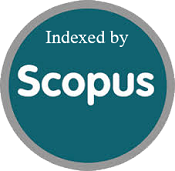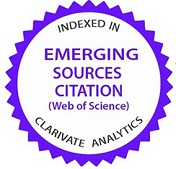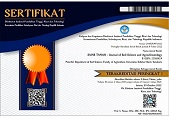Modeling the activity ratio of soil potassium using machine learning approach
Abstract
Keywords
Full Text:
PDFReferences
Ajiboye, A. G., Azeez, J. O., & Omotunde, A. J. (2015). Potassium forms and quantity–intensity relationships in some wetland soils of Abeokuta, Southwestern Nigeria. Archives of Agronomy and Soil Science, 61(10), 1393-1408. https://doi.org/10.1080/03650340.2015.1004319
Al-Hamandi, H., Al-Obaidi, M., & Aljumaily, M. (2019). Study on quantity and intensity of potassium in the alluvial soils in Baghdad. Plant Archives, 19(2), 123-130. https://www.plantarchives.org/SPL%20ISSUE%20SUPP%202,2019/21%20(123-130).pdf
Al–Obaidi, M. A. J., & Syan, C. M. H. (2022). Binary exchange of calcium, magnesium, potassium and sodium in calcareous soils in Kurdistan region of Iraq. IOP Conference Series: Earth and Environmental Science, 1120(1), 012016. https://doi.org/10.1088/1755-1315/1120/1/012016
Al Viandari, N., Harsanti, E. S., Supraptomo, E., & Wihardjaka, A. (2024). Utilization of cattle manure and potassium fertilizer on soil potassium availability and yield of cowpea (Vigna unguiculata L. Walp) in rainfed rice. Sains Tanah Journal of Soil Science and Agroclimatology, 21(2), 9. https://doi.org/10.20961/stjssa.v21i2.85535
Balittanah. (2021). Rekomendasi Pemupukan Tanaman Hortikultura per Kabupaten Se-Indonesia [Fertilization Recommendations for Horticultural Crops by Districts across Indonesia]. Soil Research Institute, Indonesian Center for Agricultural Land Resources Research and Development, Indonesian Agency for Agricultural Research and Development, Ministry of Agriculture, Republic of Indonesia. https://kikp-pertanian.id/polbangtanmalang/opac/detail-opac?id=20342
Beckett, P. H. T. (1964). Studies on Soil Potassium: I. Confirmation of the Ratio Law: Measurement of Potassium Potential. Journal of Soil Science, 15(1), 1-8. https://doi.org/10.1111/j.1365-2389.1964.tb00239.x
Bilias, F., & Barbayiannis, N. (2019). Potassium availability: An approach using thermodynamic parameters derived from quantity-intensity relationships. Geoderma, 338, 355-364. https://doi.org/10.1016/j.geoderma.2018.12.026
Bilias, F., & Barbayiannis, N. (2020). Towards a Single-Point Approach for Estimating Potassium Quantity-Intensity Parameters in Soils at Different K Saturation Ratios. Journal of Soil Science and Plant Nutrition, 20(4), 1679-1685. https://doi.org/10.1007/s42729-020-00238-6
Breiman, L. (2001). Random Forests. Machine Learning, 45(1), 5-32. https://doi.org/10.1023/A:1010933404324
Chen, L., Ren, C., Li, L., Wang, Y., Zhang, B., Wang, Z., & Li, L. (2019). A Comparative Assessment of Geostatistical, Machine Learning, and Hybrid Approaches for Mapping Topsoil Organic Carbon Content. ISPRS International Journal of Geo-Information, 8(4), 174. https://doi.org/10.3390/ijgi8040174
Cortes, C., & Vapnik, V. (1995). Support-vector networks. Machine Learning, 20(3), 273-297. https://doi.org/10.1007/BF00994018
Drzewiecki, W. (2016, 2-4 June 2016). Comparison of Selected Machine Learning Algorithms for Sub-Pixel Imperviousness Change Assessment. 2016 Baltic Geodetic Congress (BGC Geomatics). https://doi.org/10.1109/BGC.Geomatics.2016.21
Eviati, Sulaeman, Herawaty, L., Anggria, L., Usman, Tantika, H. E., . . . Wuningrum, P. (2023). Petunjuk Teknis Analisis Kimia Tanah, Tanaman, Air, dan Pupuk [Soil, Plant, Water, and Fertilizer Chemical Analysis ] (3rd ed.). Center for Standardization of Agricultural Land Resources Instruments Testing, Agricultural Instrument Standardization Agency, Ministry of Agriculture of the Republic of Indonesia. https://repository.pertanian.go.id/server/api/core/bitstreams/9313cd49-5eaa-4a45-9709-5776ce28e99f/content
Feng, S., Zhou, H., & Dong, H. (2019). Using deep neural network with small dataset to predict material defects. Materials & Design, 162, 300-310. https://doi.org/10.1016/j.matdes.2018.11.060
Gomes, L. C., Faria, R. M., de Souza, E., Veloso, G. V., Schaefer, C. E. G. R., & Filho, E. I. F. (2019). Modelling and mapping soil organic carbon stocks in Brazil. Geoderma, 340, 337-350. https://doi.org/10.1016/j.geoderma.2019.01.007
Han, T., Cai, A., Liu, K., Huang, J., Wang, B., Li, D., . . . Zhang, H. (2019). The links between potassium availability and soil exchangeable calcium, magnesium, and aluminum are mediated by lime in acidic soil. Journal of Soils and Sediments, 19(3), 1382-1392. https://doi.org/10.1007/s11368-018-2145-6
Hartati, S., Minardi, S., Hartatik, W., & Haniati, I. L. (2018). The Effects of Inorganic Fertilizer and Mineral Leucite Residues on K Uptake and Maize Yields (Zea mays L.) in Oxisols. Sains Tanah Journal of Soil Science and Agroclimatology, 15(2), 8. https://doi.org/10.15608/stjssa.v15i2.18604
Helmke, P. A., & Sparks, D. L. (1996). Lithium, Sodium, Potassium, Rubidium, and Cesium. In Methods of Soil Analysis (pp. 551-574). https://doi.org/10.2136/sssabookser5.3.c19
ICALRD. (2017). Soil Map of Brebes Regency 1:50.000. Indonesian Center for Agricultural Land Resources Research and Development.
Islam, S., Gathala, M. K., Timsina, J., Dutta, S., Salim, M., & Majumdar, K. (2023). Potassium Supplying Capacity and Contribution of Non-Exchangeable Potassium in Wetland Rice Soils in Bangladesh. Communications in Soil Science and Plant Analysis, 54(20), 2745-2762. https://doi.org/10.1080/00103624.2023.2240853
John, K., Abraham Isong, I., Michael Kebonye, N., Okon Ayito, E., Chapman Agyeman, P., & Marcus Afu, S. (2020). Using Machine Learning Algorithms to Estimate Soil Organic Carbon Variability with Environmental Variables and Soil Nutrient Indicators in an Alluvial Soil. Land, 9(12), 487. https://doi.org/10.3390/land9120487
John, K., Kebonye, N. M., Agyeman, P. C., & Ahado, S. K. (2021). Comparison of Cubist models for soil organic carbon prediction via portable XRF measured data. Environmental Monitoring and Assessment, 193(4), 197. https://doi.org/10.1007/s10661-021-08946-x
Kassa, M., Kebede, F., & Haile, W. (2021). Forms and Dynamics of Soil Potassium in Acid Soil in the Wolaita Zone of Southern Ethiopia. Applied and Environmental Soil Science, 2021(1), 9917316. https://doi.org/10.1155/2021/9917316
Kuhn, M., Wing, J., Weston, S., Williams, A., Keefer, C., Engelhardt, A., . . . Hunt, T. (2020). Package ‘caret’. https://cran.radicaldevelop.com/web/packages/caret/caret.pdf
Laekemariam, F., Kibret, K., & Shiferaw, H. (2018). Potassium (K)-to-magnesium (Mg) ratio, its spatial variability and implications to potential Mg-induced K deficiency in Nitisols of Southern Ethiopia. Agriculture & Food Security, 7(1), 13. https://doi.org/10.1186/s40066-018-0165-5
Lalitha, M., & Dhakshinamoorthy, M. (2015). Quantity-intensity characteristics of Potassium (K) in relation to potassium availability under different cropping system in alluvial soils. African Journal of Agricultural Research, 10(19), 2097-2103. https://doi.org/10.5897/AJAR2014.8947
Li, T., Liang, J., Chen, X., Wang, H., Zhang, S., Pu, Y., . . . Liu, X. (2021). The interacting roles and relative importance of climate, topography, soil properties and mineralogical composition on soil potassium variations at a national scale in China. CATENA, 196, 104875. https://doi.org/10.1016/j.catena.2020.104875
Li, Y., Rahardjo, H., Satyanaga, A., Rangarajan, S., & Lee, D. T.-T. (2022). Soil database development with the application of machine learning methods in soil properties prediction. Engineering Geology, 306, 106769. https://doi.org/10.1016/j.enggeo.2022.106769
Ließ, M., Schmidt, J., & Glaser, B. (2016). Improving the Spatial Prediction of Soil Organic Carbon Stocks in a Complex Tropical Mountain Landscape by Methodological Specifications in Machine Learning Approaches. PLOS ONE, 11(4), e0153673. https://doi.org/10.1371/journal.pone.0153673
Ludwig, B., Klüver, K., Filipinski, M., Greenberg, I., Piepho, H.-P., & Cordsen, E. (2022). Description and prediction of copper contents in soils using different modeling approaches—Results of long-term monitoring of soils of northern Germany. Journal of Plant Nutrition and Soil Science, 185(6), 876-887. https://doi.org/10.1002/jpln.202200075
Lumbanraja, R., Lumbanraja, J., Norvpriansyah, H., & Utomo, M. (2020). Perilaku Pertukaran Kalium (K) dalam Tanah, K Terangkut serta Produksi Jagung (Zea mays L.) Akibat Olah Tanah dan Pemupukan di Tanah Ultisol Gedung Meneng pada Musim Tanam Ketiga. Journal of Tropical Upland Resources (J. Trop. Upland Res.), 2(1). https://doi.org/10.23960/jtur.vol2no1.2020.69
Muliana, Anwar, S., Hartono, A., D. Susila, A., & Sabiham, S. (2018). Pengelolaan dan Pemupukan Fosfor dan Kalium pada Pertanian Intensif Bawang Merah di Empat Desa di Brebes. Jurnal Hortikultura Indonesia (JHI), 9(1), 27-37. https://doi.org/10.29244/jhi.9.1.27-37
Nadalia, D., Hartono, A., & Pulunggono, H. B. (2024). Quantity-Intensity Relationship of Soil Potassium Observed in A Shallot Production Center, Central Java, Indonesia. J. SSAAS, 30(2), 145-167.
Nelson, D. W., & Sommers, L. E. (1996). Total Carbon, Organic Carbon, and Organic Matter. In Methods of Soil Analysis (pp. 961-1010). https://doi.org/10.2136/sssabookser5.3.c34
Onyelowe, K. C., Gnananandarao, T., & Ebid, A. M. (2022). Estimation of the erodibility of treated unsaturated lateritic soil using support vector machine-polynomial and -radial basis function and random forest regression techniques. Cleaner Materials, 3, 100039. https://doi.org/10.1016/j.clema.2021.100039
Padarian, J., Minasny, B., & McBratney, A. B. (2020). Machine learning and soil sciences: a review aided by machine learning tools. SOIL, 6(1), 35-52. https://doi.org/10.5194/soil-6-35-2020
Panda, R., & Patra, S. K. (2018). Quantity-intensity relations of potassium in representative coastal soils of eastern India. Geoderma, 332, 198-206. https://doi.org/10.1016/j.geoderma.2018.07.014
Probst, P., Wright, M. N., & Boulesteix, A.-L. (2019). Hyperparameters and tuning strategies for random forest. WIREs Data Mining and Knowledge Discovery, 9(3), e1301. https://doi.org/10.1002/widm.1301
Quinlan, J. R. (1992). Learning with Continuous Classes. AI '92 (Proceedings of the 5th Australian Joint Conference on Artificial Intelligence). https://doi.org/10.1142/9789814536271
Rossiter, D. G. (2018). Past, present & future of information technology in pedometrics. Geoderma, 324, 131-137. https://doi.org/10.1016/j.geoderma.2018.03.009
Schneider, A., Augusto, L., & Mollier, A. (2016). Assessing the plant minimal exchangeable potassium of a soil. Journal of Plant Nutrition and Soil Science, 179(4), 584-590. https://doi.org/10.1002/jpln.201600095
Sharma, A., Weindorf, D. C., Wang, D., & Chakraborty, S. (2015). Characterizing soils via portable X-ray fluorescence spectrometer: 4. Cation exchange capacity (CEC). Geoderma, 239-240, 130-134. https://doi.org/10.1016/j.geoderma.2014.10.001
Soil and Plant Analysis Council Inc. (2000). Major Cations (Potassium, Calcium, Magnesium, and Sodium). In Soil Analysis Handbook of Reference Methods (1st ed.). CRC Press, . https://doi.org/10.1201/9780203739433
Song, Y.-Q., Zhao, X., Su, H.-Y., Li, B., Hu, Y.-M., & Cui, X.-S. (2018). Predicting Spatial Variations in Soil Nutrients with Hyperspectral Remote Sensing at Regional Scale. Sensors, 18(9), 3086. https://doi.org/10.3390/s18093086
Suarez, D. L. (1996). Beryllium, Magnesium, Calcium, Strontium, and Barium. In Methods of Soil Analysis (pp. 575-601). https://doi.org/10.2136/sssabookser5.3.c20
Sumner, M. E., & Miller, W. P. (1996). Cation Exchange Capacity and Exchange Coefficients. In Methods of Soil Analysis (pp. 1201-1229). https://doi.org/10.2136/sssabookser5.3.c40
Szatmári, G., Pirkó, B., Koós, S., Laborczi, A., Bakacsi, Z., Szabó, J., & Pásztor, L. (2019). Spatio-temporal assessment of topsoil organic carbon stock change in Hungary. Soil and Tillage Research, 195, 104410. https://doi.org/10.1016/j.still.2019.104410
Thomas, G. W. (1996). Soil pH and Soil Acidity. In Methods of Soil Analysis (pp. 475-490). https://doi.org/10.2136/sssabookser5.3.c16
van Reeuwijk, L. P. (2002). Procedures For Soil Analysis (6th ed.). International Soil Reference and Information Centre (ISRIC), Food and Agriculture Organization of the United Nations, Wageningen. https://www.isric.org/sites/default/files/ISRIC_TechPap09.pdf
Wang, X., Yang, Y., Lv, J., & He, H. (2023). Past, present and future of the applications of machine learning in soil science and hydrology [journal article]. Soil and Water Research, 18(2), 67-80. https://doi.org/10.17221/94/2022-SWR
Wu, Z., Chen, Y., Yang, Z., Zhu, Y., & Han, Y. (2022). Mapping Soil Organic Carbon in Low-Relief Farmlands Based on Stratified Heterogeneous Relationship. Remote Sensing, 14(15), 3575. https://doi.org/10.3390/rs14153575
Xie, K., Cakmak, I., Wang, S., Zhang, F., & Guo, S. (2021). Synergistic and antagonistic interactions between potassium and magnesium in higher plants. The Crop Journal, 9(2), 249-256. https://doi.org/10.1016/j.cj.2020.10.005
Zhou, J., Li, E., Wei, H., Li, C., Qiao, Q., & Armaghani, D. J. (2019). Random Forests and Cubist Algorithms for Predicting Shear Strengths of Rockfill Materials. Applied Sciences, 9(8), 1621. https://doi.org/10.3390/app9081621
Zhu, D., Lu, J., Cong, R., Ren, T., Zhang, W., & Li, X. (2020). Potassium management effects on quantity/intensity relationship of soil potassium under rice-oilseed rape rotation system. Archives of Agronomy and Soil Science, 66(9), 1274-1287. https://doi.org/10.1080/03650340.2019.1663830
Refbacks
- There are currently no refbacks.











.png)





